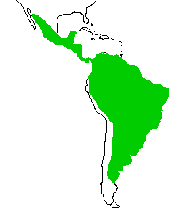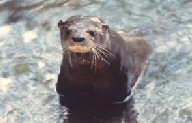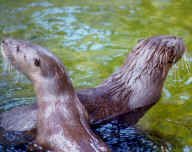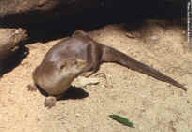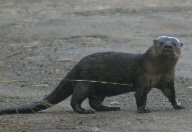 |
Last Update:
Sunday February 22, 2015 |
| •[Home] | [Site Map] | [Contact Us]• | |
| [Home] | [Members] | [News] | [Bulletin] | [Q & A] | [Species] | [Library] |
Lontra longicaudis (Olfers, 1818), the Neotropical Otter(currently being revised)
|
|
DescriptionThe Neotropical otter is part of the Mustelidae family (weasel, polecat, wolverine, tayra). This is an average sized, robustly built otter, very similar in appearance to the other American river otters. The tail can be notably long, forming more than a third of the body length. They are around 1.2-1.5m long (in some places males can reach 1.75m), usually weighing 7-15kg (in some places males can reach 25kg). The species shows sexual dimorphism - the male is generally 20-25% larger than the female. Apart from the longer tail, these otters look like Southern and North American River Otters, and for a long time, the relationships between the species were obscure, and many species previously identified are now considered subspecies and local races. Rhinarium shape varies a great deal. This species does not appear to be social. The female only tolerates the male during oestrus, and, like the Eurasian Otter, groups of otters seen together appear to be females with cubs. The main prey of the Neotropical Otter is fish (slow moving or easy to catch, conspicuous and palatable), followed by crustaceans. Insects and frogs become very important in the diet if the main prey species decrease in numbers. HabitatThese versatile otters are found in a very wide variety of environments, always associated with the presence of water: permanent, seasonal and intermittent rivers, streams and creeks, freshwater lakes, marshes and pools, saline, brackish or alkaline lakes, marshes and pools, shrub-dominated wetlands, geothermal wetlands, permanent inland deltas , shallow bays, rocky shores, estuaries, intertidal marshes, coastal freshwater, brackish and saline lagoons, reservoirs, ponds, fish farms, excavations, wastewater treatment areas, seasonally flooded and irrigated agricultural land, canals, drainage ditches (such as among rice and sugar cane plantations in Guyana), bogs, fens, swamps and peatlands. They can live in evergreen and deciduous forests, in warm and cool climates, by the sea or in the rainforest. They have been seen in the swampy areas of cushion plants and sedges surrounding glacial lakes in the High Andes of Ecuador at an altitude of 3885m. DistributionThe species ranges from northern Argentina up through south and central America to Mexico. There is then an otter-free arid zone between it and the North American River Otter. Conservation StatusRed List Category DD Near Threatened, Decreasing The species seems to be widespread, and its range does not seem to have changed, but there is no data available about population size, composition or distribution, so changes cannot be determined. (Source: IUCN Red List) Current ConcernsThere are two major threats to the species in Latin America: habitat destruction and water pollution. This otter was declared a protected species in 1973, however, it is still being hunted illegally, mainly by fishermen. Leading ResearchersMarcelo Rheingantz, Cristine Trinca, Helen Waldemarin, Juan Pablo Gallo-Reynoso Key PublicationsGeneral
Ecology
Genetics
Useful Links
Revised by Marcelo Rheingantz, July 2009 |
| [Copyright � 2006 - 2011 IUCN OSG] | [Home] | [Site Map] | [Contact Us] |

